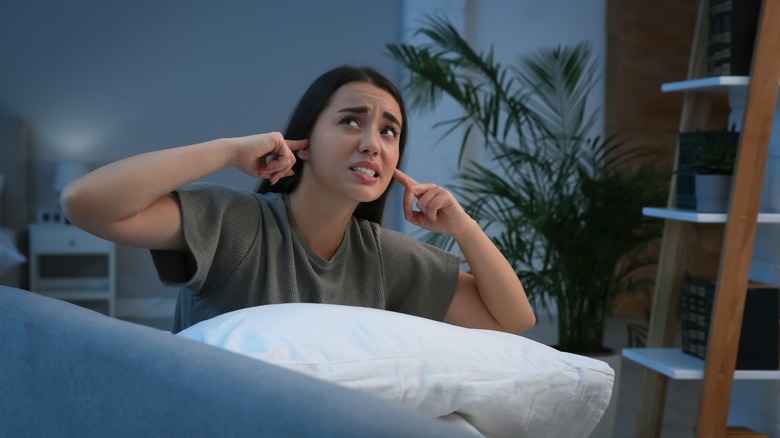The Type Of Colored Noise You Should Skip To Preserve Your Sanity
Noise is often considered to be a disruptive or unpleasant sound, such as city traffic or high-pitched microphone feedback. Some sounds, however, can be pleasant and comforting. These calming sounds are typically used in various forms of sound therapy, including a group of sounds labeled colored noise. White noise is a type of colored noise that drowns out other sounds to aid disruptive sleep patterns and even increase concentration, according to the Sleep Foundation. These low-frequency sounds also reduce stress and boost productivity. Certain types of colored noise are even used to treat physical and mental conditions such as tinnitus and anxiety.
While listening to colored noise can be incredibly helpful as a form of sound therapy, you should avoid one type of colored noise if you wish to save your ears from the grating discomfort of the nails-on-chalkboard sound. Explore the benefits of colored noise and why you might want to skip blue noise during your at-home sound therapy routine.
Why listen to colored noise?
What is colored noise, anyway? Essentially, colored noise is sound at various frequencies that are categorized into colors based on where they land on the sound frequency spectrum, according to Musician Wave. These static-like sounds are divided into several colors, including -– but not limited to -– white, pink, brown, green, and blue. Only a few types of colored noise have been studied enough to warrant scientific basis, however, and they include white noise and pink noise.
White noise, or broadband noise, is the most widely studied type of colored noise and it's associated with a flat static sound, similar to a high-intensity fan or an untuned FM radio. A 2019 study published in the journal of Contemporary Therapies in Medicine showed that white noise improves symptoms of attention deficit/hyperactivity disorder (ADHD). White noise has reportedly also improved symptoms such as disruptive sleep and poor concentration.
Pink noise has also been a common subject matter for scientific research and can be described as sounds typically found in nature, such as the wind, rain, or ocean waves (via WebMD). This lower-frequency sound produces a soothing effect and, according to a 2017 study published in the Frontiers of Human Neuroscience, it has been positively linked to deep sleep which plays a role in memory and energy levels.
Blue noise
As opposed to the calming sounds of the other types of colored noise, blue noise is known to be the least appealing sound. In fact, blue noise can sound immensely grating to the ears due to its higher frequency which produces a harsh hissing sound, not dissimilar to the sound of water rushing from a hose at intense speed, per WebMD.
That said, the high-pitched and shrill sound of blue noise has actually been the subject of scientific study. In fact, blue noise made headlines when a study was published in the Journal of Smooth Muscle Research which indicated a connection between blue noise and the brain-gut axis. Specifically, blue noise may slow down the rate of gastric activity or transit time. However, further research is required to substantiate these findings, which is why it's safe to say that you can skip over blue noise when it comes to forming your individual noise playlist.
While there lacks concrete evidence to scientifically confirm the validity of colored noise as an effective form of sound therapy, many continue to rely on colored noise as a natural form of treatment for stress and poor sleep. Regardless of whether the benefits are placebo-induced or not, there is no harm in experimenting with different types of colored noise, especially if your symptoms do improve.


